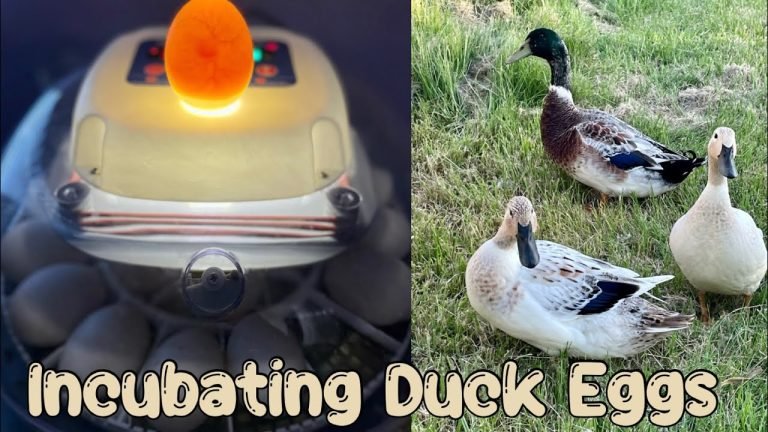Decoding Fertilized Duck Eggs: A Guide to Determining Fertility

Are you wondering if the duck eggs in your kitchen are fertilized? Whether you're a backyard farmer or just curious, it's important to know how to tell if a duck egg is fertilized. In this article, we'll explore the simple methods for determining whether a duck egg has been fertilized, from candling to the development of a visible embryo. With these easy techniques, you'll be able to confidently distinguish between fertilized and unfertilized duck eggs in no time.
What is a non-invasive way to determine if a duck egg is fertile?
To determine if a duck egg is fertile without cracking it, you can candle your duck eggs 7 days after incubation. This involves keeping the eggs warm for 7 days and then shining a light through them to see if there are any signs of development. Additionally, if the duck is at least 20 weeks old for larger breeds or 17 weeks old for smaller breeds, it is likely that the eggs are fertile.
What is the appearance of a fertilised duck egg?
The appearance of a fertilized duck egg can be quite distinct. If you are looking to confirm whether an egg is fertilized or not, check for veins and a reddish coloring. This is a clear indication that the embryo is alive and growing within the egg. As the incubation period progresses, you may even be able to see the development of the duck's bill inside the air sac of the egg. Keep an eye out for these signs, especially around day 6 or later in the incubation process.
Is the duck egg still alive?
When checking for the viability of a duck egg, the presence of clear, distinct veins is a crucial indicator of a living embryo. By carefully examining the egg, you can determine if it is still alive based on the visibility of these veins.
Unveiling the Mystery: Understanding Fertility in Duck Eggs
Duck eggs are a fascinating subject of study when it comes to fertility. The process of understanding the intricacies of duck egg fertility involves delving into the unique reproductive biology of ducks. From the formation of eggs to the mating behavior of ducks, there are many factors that contribute to the fertility of duck eggs. By unraveling the mystery behind duck egg fertility, we can gain valuable insights into reproductive science and potentially improve breeding techniques for ducks.
To understand fertility in duck eggs, it is essential to consider the environmental and biological factors that influence the process. Factors such as nutrition, temperature, and the presence of male ducks all play a significant role in determining the fertility of duck eggs. By comprehensively examining these factors, we can gain a deeper understanding of how to effectively support and enhance duck egg fertility. Ultimately, unveiling the mystery of fertility in duck eggs can lead to advancements in agricultural practices and contribute to the sustainability of duck populations.
Cracking the Code: How to Spot Fertilized Duck Eggs
Are you a fan of duck eggs and curious about how to tell if they are fertilized? Cracking the code on how to spot fertilized duck eggs is easier than you may think. First, take a close look at the eggshell. Fertilized duck eggs will often have a slightly darker and more opaque appearance compared to unfertilized eggs. This is due to the development of the embryo inside the egg. Additionally, when cracked open, fertilized duck eggs may show the presence of small red or pink spots, which are the developing blood vessels of the embryo. By paying attention to these visual cues, you can easily identify fertilized duck eggs with confidence.
In addition to visual inspection, another way to spot fertilized duck eggs is through the process of candling. This involves shining a bright light through the egg to reveal its contents. When candling a fertilized duck egg, you may see the formation of a dark shadow or network of blood vessels within the egg, indicating the presence of a developing embryo. This method is commonly used by farmers and egg enthusiasts to determine the fertility of duck eggs before incubation. By mastering the art of candling, you can become adept at identifying fertilized duck eggs and making informed decisions about their use in cooking or breeding.
In conclusion, learning how to spot fertilized duck eggs is an intriguing and useful skill for anyone interested in poultry or egg production. Whether you prefer to rely on visual cues or utilize the candling method, cracking the code on identifying fertilized duck eggs opens up a world of possibilities for cooking, breeding, and overall egg appreciation. With a keen eye and a bit of practice, you'll soon become a pro at differentiating between fertilized and unfertilized duck eggs, adding a new layer of expertise to your culinary or agricultural endeavors.
In summary, there are several methods for determining if a duck egg is fertilized, including the use of candling, egg float test, and egg cracking. By employing these techniques, you can confidently identify whether a duck egg is viable for hatching or suitable for consumption. With a little practice and knowledge, you can easily distinguish between fertilized and unfertilized duck eggs, ensuring that you make the most of your duck-raising endeavors.
